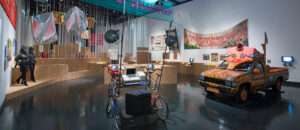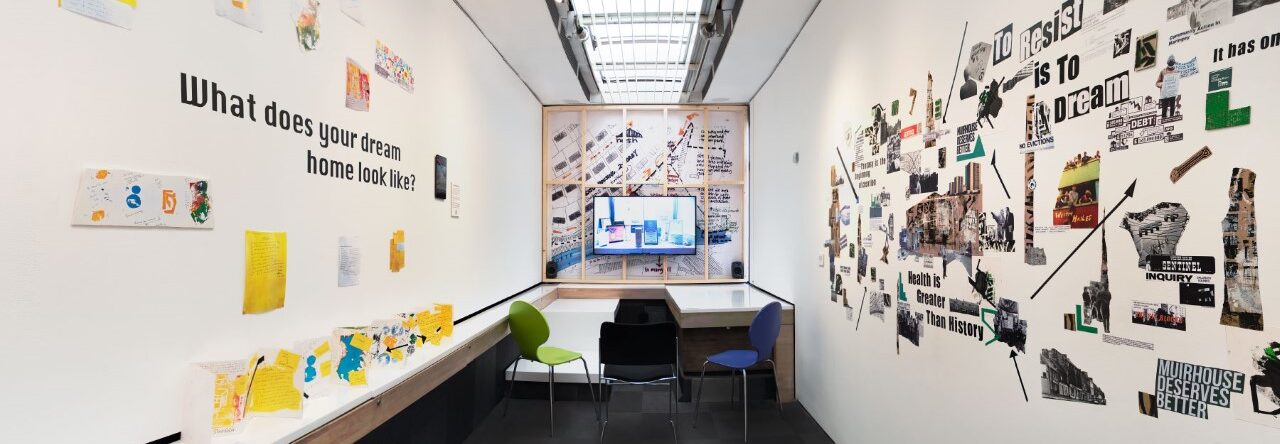A central part of our exhibition project was activism. Activism in curation, or ‘curatorial activism’ engages an exhibition with a topic that is often not given the platform it deserves, but the inclusion of something valuable to those in and around the community. Typically this activism is done to represent historically silenced groups or individuals such as women, queer artists, artists of color, among so many others. In our exhibition Resistance in Residence we focused on housing activism in Scotland. In the gallery we looked at activism and resistance through materials like Winnie Herbsteins films and the work of Cathy McCormack. The exhibition was able to continue this train of thought through other unique aspects of activism and inclusion through the living archive workshop, Lucas Priest’s SoPC walk, as well as a Q&A with Winnie Herbstein.
In Curatorial Activism: Towards an Ethics of Curating by Maura Reilly focuses on recognising curatorial activists and their work, as well as the places that could still be improved on. Reilly opens her book by discussing the commonplace exclusion of the ‘other’ in art and museums, pointing out large institutions such as the MoMA. Going on to reference the activists and artists who called out this discrimination, and stood against it, such as the Guerrilla Girls or Micol Hebron (Reilly, Curatorial Activism, 17-19). Through this she is highlighting the nature of activism in the curatorial realm. The overwhelming disregard and discrimination that is pervasive. Despite those activists who work on this topic there is still a long way to go. The text goes on to point out the entrenched formats of curation that exclude certain groups and calls for change. Calling for curators to insist on presenting diverse exhibition schedules. And calling for curators to not separate or isolate any diverse artists or collections (Reilly, Curatorial Activism, 216). Reilly delves into the role of curators and their responsibilities to activism. How the discrimination is entrenched within the curatorial system, but also expresses a hope to work together for the future. This aspect of the text emphasizes the need for activism, to represent different communities and peoples. It goes beyond the past figures one may think of as connected to activism and shows it as a current issue. Reilly recognised the work of curatorial activists while pointing out the flaws in the system and the need for changes to be inclusive to all.
Contemporary art curator Amanda Cachia explores curatorial activism that focuses on those with disabilities in the text ‘Disabling’ the museum: Curator as infrastructural activist. In this text Cachia explains noticing the lack of content containing those with disabilities in art history, apart from a few derogatory works that fail to create anything substantial or challenging. Pushing forward she also suggests for the regular inclusion of disabilities in exhibition material as well as the forethought to plan for accessibility to the exhibition and the works (Cachia, 258-259). Cachia goes on to describe her own curation of the exhibition What Can a Body Do? Where she found the exhibition centered on what the disabled body could not do. And she recalls a blind individual which brought up the exclusions, pushing Cachia to address these issues more radically (Cachia, 265-266). In this text Cachia highlights the need for change in the approach to disabilities, not only within content but in the way that it is accessed as well. She examines her own activism as a curator and finds places to improve upon to grow and be more inclusive. In the exhibition referenced she highlighted artists with disabilities and works that showed individuals with disabilities, pushing towards inclusivity in this area. While also recognising that there was room to learn and grow from feedback. This text highlights how learning and growing from that is a key part of activism.
The exhibition Disobedient Objects that took place at the Victoria and Albert museum in London is one example of a form of activism in curation. This exhibition shows objects of rebellion and political activism that were parts of social movements from the 1970s to present. Focusing on how political and social activism create creativity in art and design. It included objects from around the world that range from defaced currency, political video games, to political banners (Victoria and Albert Museum). This exhibition highlights a broad and diverse range of objects that have been used to create social and political change. They indicate the difference an individual or community can make. The collection and exhibition of these objects works to inspire through past activism.

Victoria and Albert Museum, “Disobedient Objects: About the Exhibition.” http://www.vam.ac.uk/content/exhibitions/disobedient-objects/disobedient-objects-about-the-exhibition/.
In Life Support: Forms of Care in Art and Activism, an exhibition at Glasgow Women’s Library took a different approach to activism. This exhibition addressed challenging experiences of care, health, education, housing and home life through feminist, LGBTQIA+ and anti-racist approaches. Through a collection of archive materials, artworks, and artists, it created an alternative way to understand relationships (“Life Support”). The exhibition created an alternate way of seeing everyday life and the way in which we connect with others. It challenged existing societal structures, pushing the viewer to think critically about their own life as well as the lives of those around them. This form of activism curated exhibition challenges those who visit to reevaluate their understanding of the complexities of support structures.

“Life Support: Forms of Care in Art and Activism.” Women’s Library, Glasgow Women’s Library Website, https://womenslibrary.org.uk/exhibition/life-support-forms-of-care-in-art-and-activism/.
‘Curatorial activism’ is a broad approach to both curation and activism. It allows for topics that differ widely in approach, topic, as well as specificity. It enforces the notion that there is a responsibility as curator to actively be inclusive and to keep evolving. The exhibitions mentioned above, Disobedient Objects and Life Support: Forms of Care in Art and Activism, the two are different in approach but both push the viewer to think critically about these topics. The perspectives discussed here show the importance and relevance of these topics, and the discussions that can be started through the choice to participate in ‘curatorial activism.’
Bibliography
Cachia, Amanda. “‘Disabling’ the Museum: Curator as Infrastructural Activist.” Journal of visual art practice 12, no. 3 (2013): 257–289.
Cachia, Amanda. “What Can a Body Do? – Exhibits | Haverford College.” Haverford College Exhibits, Cantor Fitzgerald Gallery, 2012, https://exhibits.haverford.edu/whatcanabodydo/files/2012/09/WCABD_Catalog.pdf.
“Life Support: Forms of Care in Art and Activism.” Women’s Library, Glasgow Women’s Library, https://womenslibrary.org.uk/exhibition/life-support-forms-of-care-in-art-and-activism/.
Reilly, Maura. Curatorial Activism: Towards an Ethics of Curating. London: Thames and Hudson Ltd, 2020. Print.
Reilly, Maura. “What Is Curatorial Activism?” ARTnews.com, ARTnews.com, 18 Nov. 2019, https://www.artnews.com/art-news/news/what-is-curatorial-activism-9271/.
Victoria and Albert Museum, Digital Media webmaster@vam.ac.uk. “Disobedient Objects: About the Exhibition.” Victoria and Albert, Victoria and Albert Museum, 20 May 2015, http://www.vam.ac.uk/content/exhibitions/disobedient-objects/disobedient-objects-about-the-exhibition/.



Leave a Reply